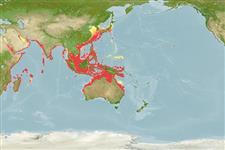Environment: milieu / climate zone / depth range / distribution range
экология
морской; мигрирует в океане (Ref. 51243); пределы глубины 10 - ? m. Tropical; 47°N - 31°S, 34°E - 154°E (Ref. 54923)
Indo-West Pacific: Red Sea and East Africa to New Guinea, north to Japan, south to Australia. Reported in New Zealand (Ref. 89192).
Length at first maturity / Size / Вес / Возраст
Maturity: Lm 60.7 range ? - ? cm
Max length : 145 cm FL самец/пол неопределен; (Ref. 40637); common length : 70.0 cm FL самец/пол неопределен; (Ref. 168); наибольший вес (опубликованные данные): 35.9 kg (Ref. 168); наибольший возраст (опубликованны данные): 19 годы (Ref. 97108)
позвонки: 39. A small species, deepest near the middle of the first dorsal fin base. The second dorsal fin is higher than the first dorsal fin; the pectoral fins are short to moderately long; swim bladder is absent or rudimentary. Lower sides and belly silvery white with colorless elongate oval spots arranged in horizontally oriented rows. The dorsal, pectoral and pelvic fins are blackish; the tip of the second dorsal and anal fins are washed with yellow; the anal fin is silvery; the dorsal and anal finlets are yellow with grayish margins; the caudal fin is blackish, with streaks of yellow green.
Predominantly neritic species avoiding very turbid waters and areas with reduced salinity such as estuaries. May form schools of varying size. Feeds on a variety of fishes, cephalopods, and crustaceans, particularly stomatopod larvae and prawns (Ref. 9684). Marketed mainly fresh and dried salted (Ref. 9684), but also smoked, canned and frozen (Ref. 9987).
Collette, B.B. and C.E. Nauen, 1983. FAO Species Catalogue. Vol. 2. Scombrids of the world. An annotated and illustrated catalogue of tunas, mackerels, bonitos and related species known to date. Rome: FAO. FAO Fish. Synop. 125(2):137 p. (Ref. 168)
Статус Красного Списка МСОП (Ref. 130435)
Угроза для людей
Harmless
Использование человеком
рыболовство: важный объект промысла; объект спортивного рыболовства: да
дополнительная информация
инструменты
Специальные отчеты
Скачать в формате XML
ресурсы в Интернет
Estimates based on models
Preferred temperature (Ref.
123201): 13 - 28.4, mean 26.5 °C (based on 1398 cells).
Phylogenetic diversity index (Ref.
82804): PD
50 = 0.5039 [Uniqueness, from 0.5 = low to 2.0 = high].
Bayesian length-weight: a=0.01413 (0.00814 - 0.02450), b=3.00 (2.85 - 3.15), in cm total length, based on LWR estimates for this species & Genus-body shape (Ref.
93245).
Trophic level (Ref.
69278): 4.5 ±0.6 se; based on diet studies.
устойчивость к внешним воздействиям (Ref.
120179): низкий, минимальное время удвоения популяции 4.5-14 лет (K=0.32; assuming tm=2-4; tmax=18.7; Fec>1M).
Prior r = 0.32, 95% CL = 0.21 - 0.49, Based on 3 stock assessments.
Fishing Vulnerability (Ref.
59153): Moderate to high vulnerability (47 of 100).
Climate Vulnerability (Ref.
125649): High to very high vulnerability (75 of 100).
Nutrients (Ref.
124155): Calcium = 48.2 [25.8, 117.5] mg/100g; Iron = 3.01 [1.19, 7.29] mg/100g; Protein = 23.2 [21.8, 24.6] %; Omega3 = 0.316 [0.191, 0.535] g/100g; Selenium = 101 [27, 327] μg/100g; VitaminA = 44 [6, 332] μg/100g; Zinc = 0.489 [0.265, 0.931] mg/100g (wet weight);
